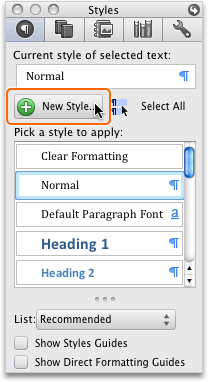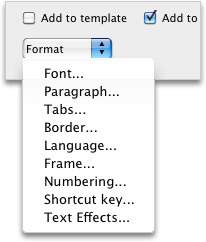Apply, change, create, or delete a style
You can apply formatting to text quickly and easily by using styles in Word. You can also change an existing style, create new styles, or delete styles to suit your needs.
Do any of the following:
Apply a style
You can apply formatting to text quickly and easily by using style in Word. Four kinds of styles are available: paragraph, character, table, and list styles.
| Icon in the Style dialog box | Style type |
| | Paragraph styles determine the look of text in a document at the paragraph level. When you apply a paragraph style to text, the paragraph style is applied to the whole paragraph. Paragraph styles are typically used to control the overall formatting of large sections of text, for example, the body of a newsletter or flyer. A paragraph style can include all the formatting definitions that a character style contains. However, it also controls all aspects of a paragraph's appearance, such as text alignment, tab stops, line spacing, and borders. By default, the Normal paragraph style is applied to all text in a blank, new document. Similarly, the List Paragraph style is applied to items in a list — for example, when you use the Bullets command to create a bulleted list. |
| | Character styles also determine the look of the text in a document, but at the character level. Character styles usually control the formatting of smaller sections of text, for example, to make one word in a paragraph stand out. Character styles contain formatting characteristics such as font name, size, color, bold, italic, underline, borders, and shading. Character styles do not include formatting that affects paragraph characteristics, such as line spacing, text alignment, indentation, and tab stops. Several built-in character styles are available, such as Emphasis, Subtle Emphasis, and Intense Emphasis. Each of these built-in styles combines formatting, such as bold, italic, and accent color, to provide a coordinated set of typographic designs. For example, applying the Emphasis character style formats text as bold, italic, in an accent color. |
| | Table styles determine the look of tables. This includes characteristics such as the text formatting of the header row, gridlines, and accent colors for rows and columns. You can use table styles to quickly apply complex formatting with one click. |
| | List styles determine the look of lists. This includes characteristics such as bullet style or number scheme, indentation, and any label text. |
-
Select the words, paragraph, list, or table that you want to apply a style to.
-
On the Home tab, under Styles, click the style that you want.

To see more styles, point to a style, and then click
 .
.Notes:
-
After you apply styles to paragraphs, headings, and other elements, you can quickly apply a set of coordinated styles to your document. On the Home tab, under Styles, click Change Quick Styles settings
 , and then click the style set that you want.
, and then click the style set that you want. -
If you are applying a style to a list, make sure to select one of the list styles. If you don't, the bullets or numbering in the list might be removed.
-
Change a style
Changing a style makes it easier to change the formatting of all text in your document that has that style applied. For example, if you applied the Heading 1 style to your chapter headings in a document, you can quickly change the formatting of all chapter headings at the same time by changing the style formatting definition.
-
On the Home tab, under Styles, click Manage the styles that are used in the document
 .
. -
Under Pick a style to apply, point to the style that you want to change, click
 next to the style, and then click Modify Style.
next to the style, and then click Modify Style. -
Make the changes that you want.
Notes:
-
If you change a style that other styles are based on, the other styles change, too. For example, most styles are based on the Normal style. Making changes to the Normal style will also change any other style that is based on Normal.
-
To use the modified style in other documents that are based on the same template, select the Add to template check box. Word adds the modified style to the template that is attached to the active document.
-
Create a style
You can create a style by defining all the settings yourself, or you can save time by modifying an existing style to create a new style.
-
On the Home tab, under Styles, click Manage the styles that are used in the document
 .
. -
Click New Style.

-
In the Name box, type a name for the new style.
-
Select the options that you want, or click the Format pop-up menu to see additional options.

Tip: To use formatted text as the basis of a new style, select the text before you click New Style
 . The New Style dialog box will open with all the attributes of the selected text already specified, and you only need to type a new name for the style.
. The New Style dialog box will open with all the attributes of the selected text already specified, and you only need to type a new name for the style.
Delete a style
In Word, you can delete any style that you create, but you can't delete any of the built-in styles included with Word. When you delete a style, Word applies the Normal style to all paragraphs that were formatted with the deleted style and removes the deleted style's definition from the styles list.
-
On the Home tab, under Styles, click Manage the styles that are used in the document
 .
. -
Under Pick a style to apply, point to the style that you want to delete, click
 next to the style, and then click Delete.
next to the style, and then click Delete.
See also
Apply, change, create, or delete a Quick Style set
See where styles are applied in a document
Copy styles and AutoText between documents or templates




No comments:
Post a Comment